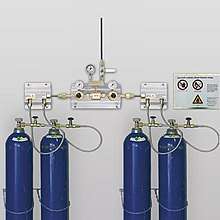Manifold (fluid mechanics)
A manifold is a wide and/or bigger pipe, or channel, into which smaller pipes or channels lead.[1]

Gas manifold
Manifolds
Types of manifolds in engineering include:
- Exhaust manifold, an engine part which collects the exhaust gases from multiple cylinders into one pipe. Also known as headers.
- Hydraulic manifold, a component used to regulate fluid flow in a hydraulic system, thus controlling the transfer of power between actuators and pumps
- Inlet manifold or "intake manifold", an engine part which supplies the air or fuel/air mixture to the cylinders
- Scuba manifold, in a scuba set, connects two or more diving cylinders
- Vacuum gas manifold, an apparatus used in chemistry to manipulate gases
- Many dredge pipe pieces
In biology manifolds are found in:
- Cardiovascular system - blood vessel manifolds etc.
- Lymphatic system
- Respiratory system
Manifolds are used in:
gollark: ++delete deletion
gollark: ...
gollark: ++delete the announcement
gollark: But how do you know which you want to see without seeing them?
gollark: Then why block me? It just means extra clicking.
References
- Scott, John S. (1992). Dictionary Of Civil Engineering. Springer. p. 269. ISBN 9780412984211.
| Wikimedia Commons has media related to Manifolds. |
This article is issued from Wikipedia. The text is licensed under Creative Commons - Attribution - Sharealike. Additional terms may apply for the media files.